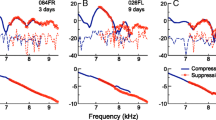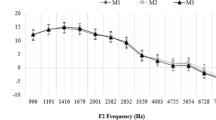Abstract
Age-related hearing loss (ARHL) is a devastating public health issue. To successfully address ARHL using existing and future treatments, it is imperative to detect the earliest signs of age-related auditory decline and understand the mechanisms driving it. Here, we explore early signs of age-related auditory decline by characterizing cochlear function in 199 ears aged 10–65 years, all of which had clinically defined normal hearing (i.e., behavioral thresholds ≤ 25 dB HL from .25 to 8 kHz bilaterally) and no history of noise exposure. We characterized cochlear function by measuring behavioral thresholds in two paradigms (traditional audiometric thresholds from .25 to 8 kHz and Békésy tracking thresholds from .125 to 20 kHz) and distortion product otoacoustic emission (DPOAE) growth functions at f2 = 2, 4, and 8 kHz. Behavioral thresholds through a standard clinical frequency range (up to 8 kHz) showed statistically, but not clinically, significant declines across increasing decades of life. In contrast, DPOAE growth measured in the same frequency range showed clear declines as early 30 years of age, particularly across moderate stimulus levels (L2 = 25–45 dB SPL). These substantial declines in DPOAE growth were not fully explained by differences in behavioral thresholds measured in the same frequency region. Additionally, high-frequency Békésy tracking thresholds above ~11.2 kHz showed frank declines with increasing age. Collectively, these results suggest that early age-related cochlear decline (1) begins as early as the third or fourth decade of life, (2) is greatest in the cochlear base but apparent through the length of the cochlear partition, (3) cannot be detected fully by traditional clinical measures, and (4) is likely due to a complex mix of etiologies.













Similar content being viewed by others
References
Abdala C, Dhar S (2012) Maturation and aging of the human cochlea: a view through the DPOAE looking glass. J Assoc Res Otolaryngol 13:403–421. https://doi.org/10.1007/s10162-012-0319-2
Abdala C, Ortmann AJ, Shera CA (2018) Reflection- and distortion-source otoacoustic emissions: evidence for increased irregularity in the human cochlea during aging. J Assoc Res Otolaryngol 19:493–510. https://doi.org/10.1007/s10162-018-0680-x
Badri R, Siegel JH, Wright BA (2011) Auditory filter shapes and high-frequency hearing in adults who have impaired speech in noise performance despite clinically normal audiograms. J Acoust Soc Am 129:852–863. https://doi.org/10.1121/1.3523476
Blackwell DL, Lucas JW, Clarke, Tainya C (2014) Summary health statistics for U.S. adults: National Health Interview Survey, 2012. Vital Health Stat 10. https://doi.org/10.1037/e403882008-001
Cooper NP, Rhode WS (1992) Basilar membrane mechanics in the hook region of cat and guinea-pig cochleae: sharp tuning and nonlinearity in the absence of baseline position shifts. Hear Res 63:163–190. https://doi.org/10.1016/0378-5955(92)90083-Y
Crowson MG, Hertzano R, Tucci DL (2017) Emerging therapies for sensorineural hearing loss. Otol Neurotol 38:792–803. https://doi.org/10.1097/MAO.0000000000001427
Cunningham LL, Tucci DL (2017) Hearing loss in adults. N Eng J Med 377:2465–2473. https://doi.org/10.1056/NEJMra1616601
Dewey JB, Applegate BE, Oghalai JS (2019) Amplification and suppression of traveling waves along the mouse organ of Corti: evidence for spatial variation in the longitudinal coupling of outer hair cell-generated forces. J Neurosci 39:1805–1816. https://doi.org/10.1523/JNEUROSCI.2608-18.2019
Dhar S, Talmadge CL, Long GR, Tubis A (2002) Multiple internal reflections in the cochlea and their effect on DPOAE fine structure. J Acoust Soc Am 112:2882–2897. https://doi.org/10.1121/1.1516757
Dorn PA, Konrad-Martin D, Neely ST et al (2001) Distortion product otoacoustic emission input/output functions in normal-hearing and hearing-impaired human ears. J Acoust Soc Am 110:3119–3131. https://doi.org/10.1121/1.1417524
Dubno JR, Ahlstrom JB (2001) Psychophysical suppression measured with bandlimited noise extended below and/or above the signal: effects of age and hearing loss. J Acoust Soc Am 110:1058–1066. https://doi.org/10.1121/1.1381024
Dubno JR, Eckert MA, Lee F-S et al (2013) Classifying human audiometric phenotypes of age-related hearing loss from animal models. J Assoc Res Otolaryngol 14:687–701. https://doi.org/10.1007/s10162-013-0396-x
Gates GA, Mills D, Nam B et al (2002) Effects of age on the distortion product otoacoustic emission growth functions. Hear Res 163:53–60. https://doi.org/10.1016/S0378-5955(01)00377-X
Gatlin AE, Dhar S (2021) History and lingering impact of the arbitrary 25-dB cutoff for normal hearing. Am J Audiol 1–4 https://doi.org/10.1044/2020_AJA-20-00181
Gorga MP, Neely ST, Dorn PA, Hoover BM (2003) Further efforts to predict pure-tone thresholds from distortion product otoacoustic emission input/output functions. J Acoust Soc Am 113:3275. https://doi.org/10.1121/1.1570433
Gratton MA, Schulte BA, Smythe NM (1997) Quantification of the stria vascularis and strial capillary areas in quiet-reared young and aged gerbils. Hear Res 114:1–9. https://doi.org/10.1016/S0378-5955(97)00025-7
Hamernik RP, Patterson JH, Turrentine GA, Ahroon WA (1989) The quantitative relation between sensory cell loss and hearing thresholds. Hear Res 38:199–211. https://doi.org/10.1016/0378-5955(89)90065-8
Hoffman HJ, Dobie RA, Losonczy KG et al (2017) Declining prevalence of hearing loss in US adults aged 20 to 69 years. JAMA Otolaryngol Head Neck Surg 143:274–285. https://doi.org/10.1001/jamaoto.2016.3527
Hughson W, Westlake H (1944) Manual for program outline for rehabilitation of aural casualties both military and civilian. Trans Am Acad Ophthalmol Otolaryngol 48(Suppl):1–15
Hunter LL, Monson BB, Moore DR et al (2020) Extended high frequency hearing and speech perception implications in adults and children. Hear Res 107922 https://doi.org/10.1016/j.heares.2020.107922
Johnson TA, Neely ST, Garner CA, Gorga MP (2006) Influence of primary-level and primary-frequency ratios on human distortion product otoacoustic emissions. J Acoust Soc Am 119:418–428. https://doi.org/10.1121/1.2133714
Kemp DT (1978) Stimulated acoustic emissions from within the human auditory system. J Acoust Soc Am 64:1386–1391. https://doi.org/10.1121/1.382104
Kim DO, Molnar CE, Matthews JW (1980) Cochlear mechanics: nonlinear behavior in two-tone responses as reflected in cochlear-nerve-fiber responses and in ear-canal sound pressure. J Acoust Soc Am 67:1704–1721. https://doi.org/10.1121/1.384297
Kujawa SG, Liberman MC (2009) Adding insult to injury: cochlear nerve degeneration after “temporary” noise-induced hearing loss. J Neurosci 29:14077–14085. https://doi.org/10.1523/JNEUROSCI.2845-09.2009
Kummer P, Janssen T, Arnold W (1998) The level and growth behavior of the 2f1−f2 distortion product otoacoustic emission and its relationship to auditory sensitivity in normal hearing and cochlear hearing loss. J Acoust Soc Am 103:3431–3444. https://doi.org/10.1121/1.423054
Lee J, Dhar S, Abel R et al (2012) Behavioral hearing thresholds between 0.125 and 20 kHz using depth-compensated ear simulator calibration. Ear Hear 33:315–329. https://doi.org/10.1097/AUD.0b013e31823d7917
Lin FR, Niparko JK, Ferrucci L (2011) Hearing loss prevalence in the United States. Arch Intern Med 171:1851–1853. https://doi.org/10.1001/archinternmed.2011.506
Lonsbury-Martin BL, Cutler WM, Martin GK (1991) Evidence for the influence of aging on distortion-product otoacoustic emissions in humans. J Acoust Soc Am 89:1749–1759. https://doi.org/10.1121/1.401009
Lutman ME, Gatehouse S, Worthington AG (1991) Frequency resolution as a function of hearing threshold level and age. J Acoust Soc Am 89:320–328. https://doi.org/10.1121/1.400513
Martin GK, Stagner BB, Chung YS, Lonsbury-Martin BL (2011) Characterizing distortion-product otoacoustic emission components across four species. J Acoust Soc Am 129:3090–3103. https://doi.org/10.1121/1.3560123
Martin GK, Stagner BB, Fahey PF, Lonsbury-Martin BL (2009) Steep and shallow phase gradient distortion product otoacoustic emissions arising basal to the primary tones. J Acoust Soc Am 125:85–92. https://doi.org/10.1121/1.3073734
Mauermann M, Kollmeier B (2004) Distortion product otoacoustic emission (DPOAE) input/output functions and the influence of the second DPOAE source. J Acoust Soc Am 116:2199–2212. https://doi.org/10.1121/1.1791719
Mills DM, Schmiedt RA (2004) Metabolic presbycusis: differential changes in the auditory brainstem and otoacoustic emission responses with chronic furosemide application in the gerbil. J Assoc Res Otolaryngol 5:1–10. https://doi.org/10.1007/s10162-003-4004-3
Muggeo VMR (2003) Estimating regression models with unknown break-points. Stat Med 22:3055–3071. https://doi.org/10.1002/sim.1545
Muggeo VMR (2017) Interval estimation for breakpoint in segmented regression: a smooth score-based approach. Aust NZ J Stat 59:311–322. https://doi.org/10.1080/00949655.2016.1149855
Müller U, Barr-Gillespie PG (2015) New treatment options for hearing loss. Nat Rev Drug Discov 14:346–365. https://doi.org/10.1038/nrd4533
Neely S, Liu Z (1993) EMAV: otoacoustic emission averager. In: Technical memorandum. Omaha, NE: Boys Town National Research Hospital
Nuttall AL, Dolan DF (1996) Steady-state sinusoidal velocity responses of the basilar membrane in guinea pig. J Acoust Soc Am 99:1556–1565. https://doi.org/10.1121/1.414732
Olusanya BO, Davis AC, Hoffman HJ (2019) Hearing loss grades and the international classification of functioning, disability and health. Bull World Health Organ 97:725–728. https://doi.org/10.2471/BLT.19.230367
Ortmann AJ, Abdala C (2016) Changes in the compressive nonlinearity of the cochlea during early aging: estimates from distortion OAE input/output functions. Ear Hear 37:603–614. https://doi.org/10.1097/AUD.0000000000000319
Oshima K, Suchert S, Blevins NH, Heller S (2010) Curing hearing loss: patient expectations, health care practitioners, and basic science. J Commun Disord 43:311–318. https://doi.org/10.1016/j.jcomdis.2010.04.002
Poling GL, Siegel JH, Lee J et al (2014) Characteristics of the 2f1-f2 distortion product otoacoustic emission in a normal hearing population. J Acoust Soc Am 135:287–299. https://doi.org/10.1121/1.4845415
R Core Team (2020) R: a language and environment for statistical computing. R Foundation for Statistical Computing, Vienna, Austria. https://www.R-project.org/
Rebillard G, Lavigne-Rebillard M (1992) Effect of reversible hypoxia on the compared time courses of endocochlear potential and 2f1-f2 distortion products. Hear Res 62:142–148. https://doi.org/10.1016/0378-5955(92)90179-Q
Ren T, He W (2020) Two-tone distortion in reticular lamina vibration of the living cochlea. Commun Biol 3:35. https://doi.org/10.1038/s42003-020-0762-2
Ruggero MA, Rich NC (1991) Furosemide alters organ of Corti mechanics: evidence for feedback of outer hair cells upon the basilar membrane. J Neurosci 11:1057–1067. https://doi.org/10.1523/JNEUROSCI.11-04-01057.1991
Ruggero MA, Rich NC, Recio A et al (1997) Basilar-membrane responses to tones at the base of the chinchilla cochlea. J Acoust Soc Am 101:2151–2163. https://doi.org/10.1121/1.418265
Schmiedt RA, Lang H, Okamura H, Schulte BA (2002) Effects of furosemide applied chronically to the round window: a model of metabolic presbyacusis. J Neurosci 22:9643–9650. https://doi.org/10.1523/JNEUROSCI.22-21-09643.2002
Schuknecht HF (1964) Further observations on the pathology of presbycusis. Arch Otolaryngol 80:369–382. https://doi.org/10.1001/archotol.1964.00750040381003
Schuknecht HF, Gacek MR (1993) Cochlear pathology in presbycusis. Ann Otol Rhinol Laryngol 102:1–16. https://doi.org/10.1177/00034894931020S101
Sewell WF (1984) The effects of furosemide on the endocochlear potential and auditory-nerve fiber tuning curves in cats. Hear Res 14:305–314. https://doi.org/10.1016/0378-5955(84)90057-1
Shera CA (2003) Wave interference in the generation of reflection- and distortion-source emissions. Biophysics of the Cochlea: from Molecules to Models 439–453. https://doi.org/10.1142/5219
Shibata SB, West MB, Du X et al (2020) Gene therapy for hair cell regeneration: review and new data. Hear Res 107981. https://doi.org/10.1016/j.heares.2020.107981
Souza NN, Dhar S, Neely ST, Siegel JH (2014) Comparison of nine methods to estimate ear-canal stimulus levels. J Acoust Soc Am 136:1768–1787. https://doi.org/10.1121/1.4894787
Spicer SS, Schulte BA (2002) Spiral ligament pathology in quiet-aged gerbils. Hear Res 172:172–185. https://doi.org/10.1016/S0378-5955(02)00581-6
Stover L, Norton SJ (1993) The effects of aging on otoacoustic emissions. J Acoust Soc Am 94:2670–2681. https://doi.org/10.1121/1.407351
Studebaker GA (1967) Intertest variability and the air-bone gap. J Speech Hear Disord 32:82–86. https://doi.org/10.1044/jshd.3201.82
Talmadge CL, Long GR, Tubis A, Dhar S (1999) Experimental confirmation of the two-source interference model for the fine structure of distortion product otoacoustic emissions. J Acoust Soc Am 105:275–292. https://doi.org/10.1121/1.424584
Uchida Y, Ando F, Shimokata H et al (2008) The effects of aging on distortion-product otoacoustic emissions in adults with normal hearing. Ear Hear 29:176–184. https://doi.org/10.1097/AUD.0b013e3181634eb8
Ueberfuhr MA, Fehlberg H, Goodman SS, Withnell RH (2016) A DPOAE assessment of outer hair cell integrity in ears with age-related hearing loss. Hear Res 332:137–150. https://doi.org/10.1016/j.heares.2015.11.006
Withnell RH, Yates GK (1998) Onset of basilar membrane non-linearity reflected in cubic distortion tone input-output functions. Hear Res 123:87–96. https://doi.org/10.1016/S0378-5955(98)00100-2
Wood SN (2001) Minimizing model fitting objectives that contain spurious local minima by bootstrap restarting. Biometrics 57:240–244. https://doi.org/10.1111/j.0006-341X.2001.00240.x
Wu P, O’Malley JT, de Gruttola V, Liberman MC (2020) Age-related hearing loss is dominated by damage to inner ear sensory cells, not the cellular battery that powers them. J Neurosci 40:6357–6366. https://doi.org/10.1523/JNEUROSCI.0937-20.2020
Acknowledgements
The authors wish to thank Rebekah Abel, Gayla Poling, Jungmee Lee, and Steve Zecker for their instrumental roles in the design and execution of the original project.
Funding
This research was supported by NIH/NIDCD Grant R01 DC008420.
Author information
Authors and Affiliations
Contributions
CCG analyzed the data and co-wrote the manuscript with SD. JS and SD designed the original study. JS critically reviewed and edited the manuscript.
Corresponding author
Additional information
Publisher's Note
Springer Nature remains neutral with regard to jurisdictional claims in published maps and institutional affiliations.
Rights and permissions
About this article
Cite this article
Glavin, C.C., Siegel, J. & Dhar, S. Distortion Product Otoacoustic Emission (DPOAE) Growth in Aging Ears with Clinically Normal Behavioral Thresholds. JARO 22, 659–680 (2021). https://doi.org/10.1007/s10162-021-00805-3
Received:
Accepted:
Published:
Issue Date:
DOI: https://doi.org/10.1007/s10162-021-00805-3




